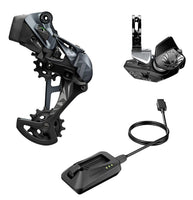If you watched our GX/X01/XX1 AXS comparison video, you’ll know that I first became acquainted with AXS on my Evil Following, on which it came stock. I hadn’t ever tried it prior to that because I didn’t quite see the point of it. I’ve never had shifting problems with a properly adjusted mechanical drivetrain, so the cost of upgrading to simply go wireless seemed out of the question.

My Evil Following, equipped with SRAM's wireless AXS drivetrain.
With the viability of this tech well proven it made sense to trickle it down into a more affordable option, so I was pretty excited about the launch of GX AXS earlier this year. We can now get everything that X01/XX1 offered for hundreds of dollars less, with what seemed to be the same quality and durability. That’s what I aimed to find out when I swapped from X01 AXS to GX AXS back in March.
I didn’t replace the wearable parts of the drivetrain—my cassette already had around 1000 miles on it, with a newer chain and chainring. With that I was able to get a direct comparison to my X01 AXS derailleur’s performance. Both GX and X01 have the same immediate, robotic shifting, with no perceptible difference in feel at all.
Unless you’re running the red X01 AXS derailleur, the physical appearance of the these drivetrains is so insignificant as be non-existent, so the question remains—is it worth it to spend the extra dough on XX1/X01, or should we stick with GX?

The three tiers of SRAM's GX AXS are not only very similar in their construction, but also look very similar.
Well, after five months and about 700 miles on this drivetrain, I can tell you that it not only performs just as well as its X01 counterpart with similar mileage, but that I have experienced no decline in performance from the system. The shifting remains as immediate and crisp as ever, and the battery life just as good, going weeks without needing a charge. The pivots in the derailleur’s linkage are just as solid as they were on day one, which cannot be said about the GX version of SRAM’s cable actuated derailleurs.
As with my X01 AXS drivetrain, I’ve not experienced the issues that are common with SRAM’s mechanical derailleurs. The mounting bolt has never backed itself out of the hanger, an easy to solve but also common occurrence. There is no cable and housing to develop slack and mess up your shifting. You’ll also never worry about those parts getting gummed up nor the sometimes frustrating process of changing them, because they simply aren’t there.

The AXS shifter remote does make for a very clean and tidy cockpit.
Now, under what circumstances should you opt for the highest end XX1 model, or the X01 version? Well, as we discussed in our first review, those options do weigh less than GX AXS by as much as 80 grams. If you are building a creme of the crop build, go with XX1. If you’re doing a sick custom with red MTX pads and all the red accents, pick yourself up the X01 AXS kit in red. But if you’re working with any sort of budget, go with the GX model. If weight is as much a concern as price, pick up an X01 cassette, which will drop 90 grams from the GX cassette; that’s more than the 65 grams upgrading to the X01 AXS derailleur saves you, and for $30 less.

SRAM's gorgeous, lightweight, and highly durable XX1 rear cassette saves more weight over a GX cassette than going from a GX AXS derailleur to an XX1 AXS derailleur does, and for less money.
If you’re like me, you’ll have wondered what moving to this wireless drivetrain actually gets you. It’s not a departure from a traditional drivetrain in any significant sense. It’s not more efficient, and the only real way it’s more adjustable is that you can change which direction the paddles move your chain. It’s not lighter, and in my opinion it doesn’t actually even shift better; it’s just different. It rids you of your cable and housing, but if your local bike shop works on your bike, then the once-a-year cable and housing swap won’t even be something you do.
Making trim adjustments is more intuitive than using a barrel adjuster. Internal cable routing, which has at times frustrated me enough to want to quit mountain biking, is no more. Even shifting itself is easier. You just click the button and pedal. There’s no feedback that comes through the cable to tell you when the chain is hitting the shift ramps on the cassette, so you don’t think about it. If you’re running an AXS seatpost, you can do cool stuff like shifting up with your left hand and down with your right. If you travel with your bike, you can easily protect the derailleur and hanger during transit by removing it from the frame.
Electric options like this are also ingrained in the future of this sport. SRAM is undoubtedly expanding the ways in which their AXS lineup will interact with the different components on our bikes and even our bikes themselves, and I strongly suspect they'll work the current Eagle AXS into that.

A gorgeous Ibis Ripmo with the GX AXS groupo and an AXS Reverb, resulting in the cleanest possible cockpit.
At Fanatik, we are all about high-end, custom Dream Builds. It’s our niche; we take pride in it, and our customers come to us for that reason. AXS is the cutting edge of bicycle technology, and if you're looking for the latest and greatest, then you should be on AXS. GX AXS is without any doubt the best value of the bunch, with no real downsides.
Related Products
More Articles You Might Like
View More:



